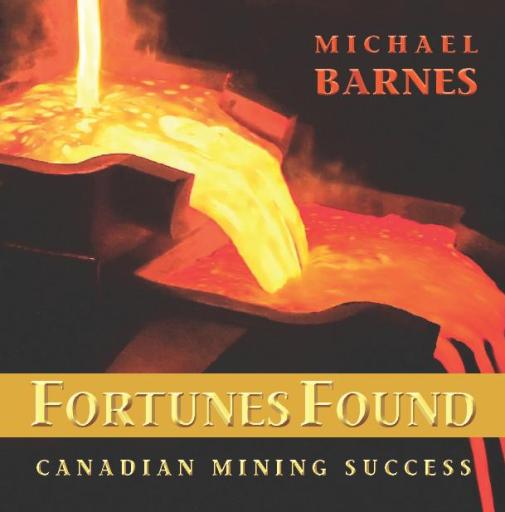 Michael Barnes is the author of more than fifty books about characters, communities, mining, and police work. He is a Member of the Order of Canada and makes his home in Haliburton, Ontario, Canada. While living in Northern Ontario most of his life, he has come to know and admire those who make their living in the mining industry.
Michael Barnes is the author of more than fifty books about characters, communities, mining, and police work. He is a Member of the Order of Canada and makes his home in Haliburton, Ontario, Canada. While living in Northern Ontario most of his life, he has come to know and admire those who make their living in the mining industry.
To order a copy of “Fortunes Found – Canadian Mining Success” go to: General Store Publishing House
For an extensive list of articles on this mineral discovery, please go to: Ontario’s Ring of Fire Mineral Discovery
Ontario’s Ring of Fire Discovery
Bruce gives us a tour and points to other residents. There are twenty drillers, some from Cyr Drilling from Western Canada, but the majority from Orbit Garant, a company from that seemingly inexhaustible supplier of the trade, Val–d’Or, Quebec. There are also three men who operate Devico directional drilling equipment, and their skills can send diamond drill rods slanting off in any desired direction. Caterer 1984 provides food services, and Matrix Aviation Solutions Inc. works to deliver services maintaining camp operation. One 1984 employee is Diane Pohl, who with her occupational first-aid certificate also is Health and Safety Officer, and in her spare time oversees housekeeping services. Her cautionary safety signs are found everywhere, as well as the Noront policy warning that states the camp is alcohol-free and illicit drug-free and advises all on the site that those who ignore this dictum face instant termination.
The camp consists of a combination of thirty-eight tents and green painted plywood cabins. One row of tents is called Sleep Alley, and signs warn passersby that drillers who work in twelve-hour shifts are sleeping. The tents are sixteen by ten feet and, like all the buildings, are well insulated. They each have four wooden bed frames with thick foam wedges. Diane provides a pillow and towel. These buildings are heated by programmed oil heaters, with the oil drum located at the back of the tent. Another row of buildings have the Noront office, dispatcher’s office, and three cabins reserved for the geologists’ activities, all of which are off limits to most personnel.
There are outhouses located around the camp and their contents are regularly emptied and incinerated. In addition, there is a cabin with large composting toilets. Diane advises that one does one’s business, scatters a little dry bulking material and turns a handle to allow the material to circulate. There are also hot and cold water basins here and in the shower cabin. Bubbling away along the side of one wall are large vats containing the reverse osmosis water system provided by Global Hydration of Kakebeka Falls. The system provides drinking water, and even that for washing is treated.
Locals who visit the camp are foxes and one lone wolf, who is not seen but whose tracks appear in the mud-filled walkways outside the camp. A whisky jack (Canada jay to the uninitiated) flies by with a sliver of bright tape in his beak. Other “visitors” make contact via the electronic medium. There is a large dish for satellite radio communication; dial a three-digit number and the head office is on the line from Toronto. One dish provides Internet service, and there are satellite television dishes. One cabin has a television and easy chairs and a telephone enabling residents to call home whenever they wish.
Two head office people fly in on the last inbound flight of the day. Jim Mungall is the chief geologist and also a mining faculty professor at the University of Toronto. Exploration Manager Jim Atkinson draws the author aside. He reminds him of the confidentiality policy here; no drilling results may be passed on unless released by the company. He shows off the core cabins where the cylindrical nq cores (they open a hole 72.8 mm in diameter and give a 47.6-mm rock core) are examined, logged, and sent to be stored in the vast outside storage racks. There is a tiny “core library” containing one specimen of each of the minerals found here. Jim Atkinson offers up a gift, a small piece of massive chromite with thousands of tiny grains seen under the loupe.
The kitchen and dining tent is an eye-opener, with its large refrigerators and a full-sized stove that would grace any large restaurant. Bruce MacLachlan answers the obvious question: How can such heavy equipment make its way to this remote location? Answer: In winter when there is fifty inches of lake ice, a giant Hercules freighter aircraft can touch down, bringing vehicles and all manner of heavy items. Chocolate éclairs were the dessert the day before. Today there is a choice of pan-fried Arctic char or honey-chilli-lime-marinated pork tenderloin.
Head cook Robert Waters, once a chef with his own restaurant, offers a delicate orange sauce for the dish. Second cook Michael Sheane points out the vegetables and other food provided for the meal. In the background, baker Catherine Campbell–Valois is working on buns, and bull cook Lorraine Amikon cheerfully washes dishes.
Part 5 of 6 – To be continued























